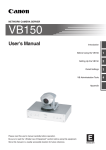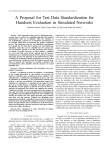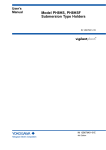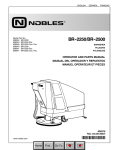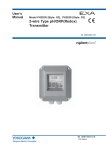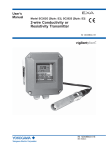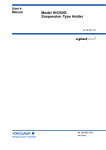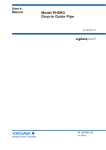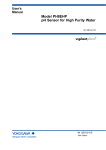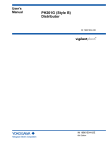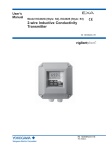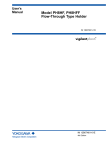Download 2. System Configuration of the EXAPH Series
Transcript
<Int> <Ind> <Rev> Technical Information TI 12B07A03-02E EXA PH Series Process pH Meters Measurement System and Applications Contents 1. 2. Overview of the EXA PH Series ..................................................................................................... 2 System Configuration of the EXA PH Series .................................................................................. 3 2.1 2.2 2.3 3. Holders ....................................................................................................................................... 10 3.1 3.2 3.3 3.4 3.5 3.6 3.7 3.8 4. Guide Pipe (PH8HG) ......................................................................................................................... 11 Immersion Type Holder (PH8HS) ...................................................................................................... 11 Explosion-proof Immersion Type Holder (PH8HSF) ........................................................................... 11 Flow-Through Type Holder (PH8HF) ................................................................................................. 12 Explosionproof Flow-Through Type Holder (PH8HFF) ....................................................................... 12 Suspension Type Holder (HH350G) ............................................................................................. ..... 12 Angled Floating Ball Holder (PB350G) .............................................................................................. 13 Vertical Floating Ball Holder (PB360G) .............................................................................................. 13 Cleaning Systems .......................................................................................................................14 4.1 4.2 4.3 4.4 4.5 5. 4-Wire pH Converter System (PH400G) .............................................................................................. 3 2-Wire pH Transmitter System (PH202G, PH202SJ) ........................................................................... 5 Panel Mount pH Measurement System (PH100) ................................................................................. 9 Setting of Automatic Cleaning in the Converter/Transmitter ............................................................... 14 Ultrasonic Cleaning System .............................................................................................................. 15 Jet Cleaning System ......................................................................................................................... 17 Brush Cleaning System ..................................................................................................................... 17 Chemical Cleaning System (AUTO CLEAN) ..................................................................................... 18 Functions and Features of the EXA PH Series ............................................................................. 21 5.1 5.2 5.3 5.4 One-Touch Calibration ....................................................................................................................... 21 90% Response Time Check .............................................................................................................. 21 Failure Diagnosis ............................................................................................................................... 21 Calibration ......................................................................................................................................... 22 5.4.1 5.4.2 5.5 5.6 5.7 5.8 6. Temperature Compensation for a pH Sensor ..................................................................................... 23 Temperature Correction of a Sample Solution (High Purity Water) ..................................................... 25 Liquid Earth ....................................................................................................................................... 26 Sensor Impedance Check ................................................................................................................. 26 pH Measurement under Special Conditions .................................................................................28 6.1 pH Measurement at High Alkalinity ........................................................................................... ......... 28 6.1.1 6.1.2 6.2 6.3 6.4 6.5 6.6 Measurement in Oil-Containing Water .......................................................................................................... 33 Measurement in Water-Soluble Organic Solvents ......................................................................................... 33 Automatic pH Control ..................................................................................................................34 Maintenance ................................................................................................................................40 8.1 Periodic Maintenance ........................................................................................................................ 40 8.1.1 8.1.2 8.1.3 8.2 8.3 Electrode Cleaning ........................................................................................................................................ 40 Calibration Using Standard Solutions ............................................................................................................ 40 Refilling with a KCl Solution ........................................................................................................................... 40 Inspection and Preventive Maintenance ............................................................................................ 41 8.2.1 8.2.2 8.2.3 8.2.4 8.2.5 ◆ Mechanism of Characteristic Deterioration in a High-Alkaline Solution ......................................................... 28 Temperature Dependence of the pH Value of a High-Alkaline Solution ......................................................... 29 pH Measurement in Solutions Live with Electricity ............................................................................. 29 pH Measurement in Solutions of Low Ion Concentration (High Purity Water) ..................................... 30 pH Measurement When Electrode Coating Occurs ........................................................................... 32 pH Measurement under High Pressure ............................................................................................. 33 pH Measurement in Solutions Containing Organic Solvents .............................................................. 33 6.6.1 6.6.2 7. 8. Two-Point Calibration .................................................................................................................................... 22 One-Point Calibration .................................................................................................................................... 23 Checking for Moisture Ingress in the pH Converter/Transmitter .................................................................... Checking for Dirt on the Window of the pH Converter/Transmitter ................................................................ Checking the O-Ring for Deterioration .......................................................................................................... Checking the Ultrasonic Cleaning Device for Corrosion ................................................................................ Checking the KCl Refill Tube for Damage ..................................................................................................... 41 41 41 41 41 Troubleshooting ................................................................................................................................. 42 Revision Record ......................................................................................................................... 43 TI 12B07A03-02E ©Copyright Mar. 2007(YK) 1st Edition Mar. 2007(YK) Yokogawa Electric Corporation <Toc> <Ind> 1. <1. Overview of the EXA PH Series > 2 Overview of the EXA PH Series Recent advances in digital and information technologies have propelled digitalization and computerization of various instruments. At the same time, it has become possible to develop compact, easy-to-use products by the utilization of high functionality of new materials. The EXA PH Series has been developed based on YokogawaÕs experience with predecessor models, P/H Cell and PH∑, and additionally incorporates new technologies to meet diverse needs of users. It has been designed with the aims of: (1) offering ease of use; (2) accommodating various application requirements; (3) securing maintainability; and (4) improving cost performance. Features of the EXA PH Series (1) Various types of pH sensors for a wide range of applications General pH sensors use Ryton, an engineering plastic that is mechanically strong and is comparable to Teflon in terms of corrosion resistance and heat resistance. Besides these, various types of pH sensors are available to accommodate a wide range of applications. (2) Failure detection and one-touch calibration The microprocessor-based pH converter/transmitter can monitor sensor failure even during pH measurement. It also has three tables of preprogrammed standard solution values, based on which one-touch calibration can be performed. Routine operation such as calibration using standard solutions can be conducted without opening the case cover. This eliminates risk of insulation deterioration or other failures even if such operation is needed under bad weather. (3) Reliable measurement system with excellent maintainability As for process analyzers, long-term stabilization in actual processes is of prime importance. To meet a broad range of applications appropriately, a large selection of holders and cleaning systems are available. With an appropriate selection of a holder and cleaning system that meet the application requirements, highly reliable measurement system with excellent maintainability can be achieved. This document is intended for those who use a process pH meter for the first time as well as for those who have experience and expertise, and describes pH measurement systems and their applications. TI 12B07A03-02E 1st Edition : Mar. 30,2007-00 <Toc> <Ind> 2. 3 <2. System Configuration of EXA PH Series > System Configuration of the EXA PH Series There are three systems in the EXA PH Series. (1) 4-wire pH converter system for medium-scale wastewater treatment systems and general pH measurement systems (2) 2-wire pH transmitter system for large-scale instrumentation and for use in hazardous areas. (3) Panel mount pH measurement system for simple instrumentation such as smallscale wastewater treatment systems ¥ The cleaning system can be attached to the 4-wire pH converter system and the 2-wire pH transmitter system. ¥ The 2-wire pH transmitter system has an intrinsically safe version. 2.1 4-Wire pH Converter System (PH400G) The following is an example of the 4-wire pH converter system configuration. 4-Wire pH Converter PH400G Terminal Box PH8TBG/PH8TBS Distance between PH400G and sensor is normally up to 5 m and maximum is 20 m by use of terminal box. Power Supply 88-132/176-264 V AC, 50/60 Hz Solenoid Valve for Jet/Brush Cleaning, PH8MV Flow-Through Holder PH8HF Water or Air Cleaning method: ultrasonic/jet/brush Holder: flow-through/ immersion/high purity water Fail Contact Output Maintenance Status Contact Output High/Low Alarm, Control Contact Output Cleaning Contact Output Wash cycle/time and relaxation time can be set on PH400G. Used in accordance with cleaning method Sensors Flow-through Holders dKCl Replenish-free Type PH8ERP dXerolyt HA405/HA406 T P Immersion Holders dGuide Pipe PH8HG Cleaning Accessories Jet/Brush Cleaning Accessories PH8AX dSensor Stand dSolenoid Valve PH8MV dCalibration Reagent and KCl solution ical Processes 5/DPA406 dHydrofluoric dpH, Redox and Acid-Resistant, HF405 Temperature Sensor, FU20 U20 dF P W P nic/ sh dImmersio PH8HS dUltrasonic Oscillator PUS400G Ultrasonic// Jet/Brush No Cleaning Features: ¥ Monitoring of sensor failure even during pH measurement ¥ One-touch, automatic calibration using standard solutions Three tables of standard solution values are preprogrammed for easy calibration. ¥ Automatic check of deterioration of electrode characteristics during automatic calibration TI 12B07A03-02E 1st Edition : Mar. 30,2007-00 <Toc> <Ind> 4 <2. System Configuration of EXA PH Series > ¥ Routine operation performed without opening the case cover There is no need to open the case cover for routine operation such as calibration using standard solutions. This eliminates risk of insulation deterioration even if such operation is needed in rainy weather. ¥ User configurable transmission signal range: the span should be at least 1 pH. ¥ Built-in wash timer function ¥ Expanded contact output functions 4-Wire pH Converter System Configuration (General Purpose) pH Sensors dKCl Replenish-free Type PH8ERP dXerolyt HA405/HA406 Holders, Holders with Cleaning System dGuide Pipe PH8HG pH Converter d4-Wire pH Converter PH400G dSuspension Type HH350G <No Cleaning> <With Jet Cleaning> pH NO MODE > > MEASURE AUT CAL MAN CAL TCMP DISP HOLD YES ENT CONTACTS S1 S2 S3 FAIL dFor Chemical Processes DPA405/DPA406 dImmersion Type PH8HS dKCl Refillable Type PH8EFP dHydrofluoric Acid-Resistant HF405 dpH, Redox and Temperature Sensor FU20 dAngled Floating Ball Holder PB350G dVertical Floating Ball Holder PB360G No Cleaning Ultrasonic Cleaning Jet Cleaning Brush Cleaning dFlow-through Type PH8HF Accessories dSensor Stand Cleaning Device dUltrasonic Oscillator PUS400G PH8AX dCalibration Reagent and KCl Solution No Cleaning Ultrasonic Cleaning Jet Cleaning Brush Cleaning 4-Wire pH Converter System Configuration (For High Purity Water) dFor High Purity Water PH8EHP Holder Accessories pH Converter d4-Wire pH Converter PH400G dFor High Purity Water PH8HH (Same as for General Purpose) pH MEASURE AUT CAL MAN CAL TCMP DISP HOLD YES NO MODE > > pH Sensor ENT CONTACTS S1 S2 S3 FAIL F0201.EPS TI 12B07A03-02E 1st Edition : Mar. 30,2007-00 <Toc> <Ind> 2.2 5 <2. System Configuration of EXA PH Series > 2-Wire pH Transmitter System (PH202G, PH202SJ) There are two types of 2-wire pH transmitter systems: a general type, PH202G, and an intrinsically safe type (TIIS certification), PH202SJ. The following shows an example of the 2-wire pH transmitter system configuration. When the transmitter is used in conjunction with an ORP sensor, it serves as an ORP meter. 2-Wire pH/ORP Transmitter Dedicated Distributor for EXAPH/EXAOR PH201G General purpose type: PH202G Intrinsically safe type: PH202SJ Analog Output, 1-5 V DC Used in combination Fail Contact Output Maintenance Status Contact Output Power Supply 20-130 V DC/ 80-138 V AC, 47-63 Hz Transmitter can be set so that a digital signal is superimposed on 4-20 mA signal. PH201G distributor can receive the digital signal and provides contact outputs during failure and/or maintenance. In case of general purpose type: Hazardous Area Area Or General Distributors SDBT, SDBS Safety Barrier Analog Output, 1-5 V DC Terminal Box WTB10-PH1/-PH2 Distance between PH202G/PH202SJ and sensor is normally up to 5 m and maximum is 20 m by use of terminal box. In case of intrinsically safe type: Power Supply 20-130 V DC/ 80-138 V AC, 47-63 Hz 700 m max. (CEVS Cable) 350 m max. (CVVS Cable) (Reference Only) Solenoid Valve for Jet/Brush Cleaning, PH8MV/PH8MVF Flow-Through Holder PH8HF To PH201G Water or Air Cleaning method: ultrasonic/jet/brush Holder: flow-through/ immersion/high purity water Cleaning Contact Output Wash cycle/time and relaxation time can be set on PH202G/PH202SJ. Used in accordance with cleaning method Sensors Flow-through Holders dKCl Replenish-free Type PH8ERP dXerolyt HA405/HA406 Ty mical Processes 05/DPA406 dHydrofluoric dpH, Redox and Acid-Resistant, HF405 Temperature Sensor, FU20 U20 dF P W P Immersion Holders dGuide Pipe PH8HG nic/ sh dImmersio PH8HS Cleaning Accessories Jet/Brush Cleaning Accessories PH8AX dSensor Stand dSolenoid Valve PH8MV PH8MVF dCalibration Reagent and KCl solution dUltrasonic Oscillator PUS400G Ultrasonic// Jet/Brush No Cleaning Features: ¥ Monitoring of sensor failure even during pH measurement ¥ One-touch, automatic calibration using standard solutions Three tables of standard solution values are preprogrammed for easy calibration. ¥ Routine operation performed without opening the case cover There is no need to open the case cover for routine operation such as calibration using standard solutions. This eliminates risk of insulation deterioration even if such operation is needed in rainy weather. TI 12B07A03-02E 1st Edition : Mar. 30,2007-00 <Toc> <Ind> 6 <2. System Configuration of EXA PH Series > ¥ Built-in wash timer function When the dedicated distributor is used, it can provide a drive contact for solenoid valve for cleaning. 2-Wire pH Transmitter System Configuration (General Purpose, Non-Explosionproof Types) pH Sensors dKCl Replenish-free Type PH8ERP Holders, Holders with Cleaning System dSuspension Type HH350G <No Cleaning> <With Jet Cleaning> dGuide Pipe PH8HG dXerolyt HA405/HA406/ HA485 dFor Chemical Processes DPA405/DPA406/ DPA485 dImmersion Type PH8HS dKCl Refillable Type PH8EFP dHydrofluoric Acid-Resistant HF405 Distributors dDedicated Distributor for EXA PH PH201G ·Maintenance Status Contact Output ·Cleaning Contact Output ·Fail Contact Output dAngled Floating Ball Holder PB350G dGeneral Distributors SDBT, SDBS, etc. dVertical Floating Ball Holder PB360G dpH, Redox and Temperature Sensor FU20 No Cleaning Ultrasonic Cleaning Jet Cleaning Brush Cleaning dFlow-through Type PH8HF Accessories dSensor Stand PH8AX Cleaning Device dUltrasonic Oscillator PUS400G dCalibration Reagent and KCl Solution pH/ORP Transmitter d2-Wire pH/ORP Transmitter PH202G HOLD No Cleaning Ultrasonic Cleaning Jet Cleaning Brush Cleaning FAIL YES N O ENT MODE MEASURE CAL DISPLA Y HOLD MODE 2-Wire pH Transmitter System Configuration (For High Purity Water, Non-Explosionproof Types) pH Sensor dFor High Purity Water PH8EHP Holder Accessories dFor High Purity Water PH8HH pH/ORP Transmitter d2-Wire pH/ORP Transmitter PH202G (Same as for General Purpose) HOLD FAIL YES N O ENT MODE MEASURE CAL DISPLA Y HOLD MODE Distributors (Same as for General Purpose and Non-Explosionproof Types) F0202.EPS TI 12B07A03-02E 1st Edition : Mar. 30,2007-00 <Toc> <Ind> 7 <2. System Configuration of EXA PH Series > 2-Wire pH Transmitter System Configuration (General Purpose, Explosionproof Types) pH Sensors Holders, Holders with Cleaning System dKCl dXerolyt Replenish-free HA405/HA406/ Type HA485 PH8ERP dFor Chemical Processes DPA405/DPA406/ DPA485 dKCl Refillable Type dHydrofluoric PH8EFP Acid-Resistant HF405 dGuide Pipe PH8HG dSuspension Type HH350G <No Cleaning> <With Jet Cleaning> Distributors dDedicated Distributor for EXA PH PH201G dImmersion Type PH8HS ·Maintenance Status Contact Output ·Cleaning Contact Output ·Fail Contact Output dAngled Floating Ball Holder dGeneral Distributors PB350G SDBT, SDBS, etc. No Cleaning Jet Cleaning Brush Cleaning dVertical Floating Ball Holder dFlow-through Type PH8HF PB360G dpH, Redox and Temperature Sensor FU20 Safety Barrier dBARD-800 No Cleaning Jet Cleaning Brush Cleaning Accessories PH8AX dSensor Stand dCalibration Reagent and KCl Solution BARD -800 A B C 3 2 1 Holder with Ultrasonic Cleaning dImmersion Type Holder with Cleaning Device Explosionproof Type Ultrasonic dExplosionproof Type Cleaning Ultrasonic Oscillator PH8HSF PH8USF dFlow-through Type dAlarm Box Holder with PH8AL Explosionproof Type Ultrasonic Cleaning Ultrasonic PH8HFF Wave pH/ORP Transmitter d2-Wire pH/ORP Transmitter, PH202SJ HOLD FAIL YES N O ENT MODE MEASURE CAL DISPLA Y HOLD MODE 2-Wire pH Transmitter System Configuration (For High Purity Water, Explosionproof Types) pH Sensor dFor High Purity Water PH8EHP Holder Accessories dFor High Purity Water PH8HH pH/ORP Transmitter Distributors/Safety Barrier d2-Wire pH/ORP Transmitter, PH202SJ (Same as for General Purpose) HOLD FAIL YES N O ENT MODE MEASURE CAL DISPLA Y HOLD MODE (Same as for General Purpose and Explosionproof Types) F0203.EPS TI 12B07A03-02E 1st Edition : Mar. 30,2007-00 <Toc> <Ind> 8 <2. System Configuration of EXA PH Series > Ultrasonic Cleaning System for Hazardous Areas Explosionproof Construction Measurement: i3aG4 Cleaning: d2G4 Holders with flameproof ultrasonic cleaner pH/ORP transmitter intrinsically safe PH202SJ pH sensor PH8ERP or PH8EFP HOLD FAIL YES N O ENT Safety barrier BARD-800 Distributor PH201G MODE MEASURE CAL DISPLA Y HOLD BARD -800 A B C 3 2 1 MODE Signal cable Sensor cable d1 to 5 V DC dMaintenance contact output dFailure contact output max. 700 m *1 max. 350 m *2 (Reference only) *1 When using CEV-S cable *2 When using CVV-S cable Safety barrier BARD-800 pH/ORP transmitter intrinsically safe PH202SJ HOLD PH8HSF FAIL YES N O ENT general-purpose Distributor SDBT MODE BARD -800 A B C 3 2 1 MEASURE CAL DISPLAY HOLD MODE Signal cable Sensor cable d1 to 5 V DC max. 700 m *1 max. 350 m *2 (Reference only) Explosionproof ultrasonic oscillator PH8USF Alarm box PH8AL Ultrasonic cable AC power PH8HFF Hazardous area Non hazardous area F0204.EPS Jet and Brush Cleaning System for Hazardous Areas Explosionproof Construction Measurement: i3aG4 Cleaning: d2G4 General pourpose holders pH/ORP transmitter intrinsically safe PH202SJ pH sensor PH8ERP or PH8EFP HOLD FAIL YES N O ENT Safety barrier BARD-800 Distributor PH201G MODE MEASURE CAL DISPLAY HOLD BARD -800 A B C 3 2 1 MODE Signal cable Sensor cable d1 to 5 V DC dMaintenance contact output dFailure contact output max. 700 m *1 max. 350 m *2 (Reference only) *1 When using CEV-S cable *2 When using CVV-S cable Explosionproof solenoid valve PH8MVF PH8HS Water or Air AC power PH8HF Solenoid valve drive cable Hazardous area Non hazardous area F0205.EPS TI 12B07A03-02E 1st Edition : Mar. 30,2007-00 <Toc> <Ind> 2.3 9 <2. System Configuration of EXA PH Series > Panel Mount pH Measurement System (PH100) This is a system using the indoor type panel mount pH converter, PH100. Features: ¥ 96 x 96 mm panel mount design for indoor use ¥ Easy access to routine maintenance mode ¥ Large 4-digit display ¥ One analog output and two/four contact outputs as standard ¥ One-touch, simple automatic calibration ¥ Various self-diagnostic functions Panel Mount pH Measurement System Configuration pH Sensors dKCl Refillable Type PH10FP Holders dKCl Replenish-free Type PH10RP dGuide Pipe, PH10HG dImmersion Type, PH10HLD Liquid Level Liquid Level dKCl Replenish-free Type dpH, Redox and Temperature Sensor PH8ERP FU20 pH Conveter dKCl Refillable Type PH8EFP dPanel Mounted pH Converter PH10 Terminal Box/Extension Cable dTerminal Box WTB100 dExtension Cable WF100 *: Terminal box and extension cable are used where pH converter is installed remotely (10 m or more) from pH sensor. Maximum total connection cable length: 50 m (Sensor cable length included.) F0206.EPS TI 12B07A03-02E 1st Edition : Mar. 30,2007-00 <Toc> <Ind> 3. <3. Holders > 10 Holders The following types of holders for pH sensor are available. ¥ Guide pipe: PH8HG ¥ Immersion type: PH8HS ¥ Explosion-proof immersion type: PH8HSF ¥ Flow-through type: PH8HF ¥ Explosion-proof flow-through type: PH8HFF ¥ Suspension type: HH350G ¥ Angled floating ball type: PB350G ¥ Vertical floating ball type: PB360G dGuide Pipe PH8HG dSuspension Type HH350G <No Cleaning> <With Jet Cleaning> dImmersion Type PH8HS/PH8HSF dAngled Floating Ball Holder PB350G No Cleaning Ultrasonic Cleaning Jet Cleaning Brush Cleaning dFlow-through Type PH8HF/PH8HFF dVertical Floating Ball Holder PB360G No Cleaning Ultrasonic Cleaning Jet Cleaning Brush Cleaning F0301.EPS TI 12B07A03-02E 1st Edition : Mar. 30,2007-00 <Toc> <Ind> 3.1 11 <3. Holders > Guide Pipe (PH8HG) This is the simplest type of holder. ¥ Applicable pH sensors: General pH sensors (PH8EFP, PH8ERP) pH, Redox and temperature sensor (FU20) ¥ Material of holder body: Polypropylene or PVC ¥ Pipe length: 3.2 2m Immersion Type Holder (PH8HS) This holder can be equipped with various cleaning systems (ultrasonic cleaning, jet cleaning or brush cleaning) and is available for flange connection. ¥ Applicable pH sensors: General pH sensors (PH8EFP, PH8ERP) Solid electrolyte pH sensors (HA405, HA406) pH sensors for chemical processes (DPA405, DPA406) Hydrofluoric acid-resistant pH sensor (HF405) ¥ Material of holder body: Polypropylene or stainless steel (SUS316 equivalent) ¥ Cleaning utility: Water jet Water brush Air jet Pressure (kPa) 200 to 400 + liquid pressure 100 to 250 + liquid pressure 200 to 400 + liquid pressure Flow Rate 5 to 20 l/min 20 to 30 l/min 100 to 300 Nl/min Air brush 150 to 250 + liquid pressure 300 to 600 Nl/min T0301.EPS (Note) ¥ An adapter is required when using special pH sensors. ¥ Brush cleaning and ultrasonic cleaning cannot be used with special pH sensor. 3.3 Explosion-proof Immersion Type Holder (PH8HSF) This holder should be used when an ultrasonic cleaning system is used in a hazardous area. For the pH measurement system without cleaning system or with jet/brush cleaning system, the PH8HS holder should be used. ¥ Applicable pH sensors: General pH sensors (PH8EFP, PH8ERP) ¥ Material of holder body: Polypropylene or stainless steel (SUS316 equivalent) ¥ Construction: Explosion-proof (TIIS d2G4) TI 12B07A03-02E 1st Edition : Mar. 30,2007-00 <Toc> <Ind> 3.4 12 <3. Holders > Flow-Through Type Holder (PH8HF) This holder can be equipped with various cleaning systems and is used, for example, for direct connection to a piping line. ¥ Applicable pH sensors: General pH sensors (PH8EFP, PH8ERP) Solid electrolyte pH sensors (HA405, HA406) pH sensors for chemical processes (DPA405, DPA406) Hydrofluoric acid-resistant pH sensor (HF405) ¥ Material of holder body: Polypropylene or stainless steel (SUS316 equivalent) ¥ Cleaning utility: Water jet Pressure (kPa) 200 to 400 + liquid pressure Flow Rate 5 to 20 l/min Water brush Air jet 100 to 250 + liquid pressure 200 to 400 + liquid pressure 20 to 30 l/min 100 to 300 Nl/min Air brush 150 to 250 + liquid pressure 300 to 600 Nl/min T0301.EPS (Note) ¥ An adapter is required when using special pH sensors. ¥ Brush cleaning and ultrasonic cleaning cannot be used with special pH sensor. 3.5 Explosionproof Flow-Through Type Holder (PH8HFF) This holder should be used when an ultrasonic cleaning system is used in a hazardous area. For the pH measurement system without cleaning system or with jet/brush cleaning system, the PH8HF holder should be used. ¥ Applicable pH sensors: General pH sensors (PH8EFP, PH8ERP) ¥ Material of holder body: Polypropylene or stainless steel (SUS316 equivalent) ¥ Construction: 3.6 Explosion-proof (TIIS d2G4) Suspension Type Holder (HH350G) This holder is designed so that the sensor is separately removed from the holder and pulled out of liquid. It is suited to be used when the sensing point is deep or the ceiling is low. ¥ Applicable pH sensors: General pH sensors (PH8EFP, PH8ERP) ¥ Material of holder body: Polypropylene or stainless steel (SUS316 equivalent) ¥ Material of guide pipe and mounting bracket: Stainless steel (SUS304 equivalent) ¥ Cleaning system: Jet cleaning TI 12B07A03-02E 1st Edition : Mar. 30,2007-00 <Toc> <Ind> 13 <3. Holders > ¥ Cleaning utility: Water jet Air jet Pressure 100 to 200 kPa 100 to 200 kPa Flow Rate 5 to 20 l/min 10 to 20 Nl/min T0302.EPS 3.7 Angled Floating Ball Holder (PB350G) This holder is suited to be used in sewage and industrial wastewater treatment plants where the sensor is soiled or stained in a short period of time. It secures measurement even if the liquid level changes. ¥ Applicable pH sensors: General pH sensors (PH8EFP, PH8ERP) ¥ Materials of holder body: ABS resin, nitrile rubber (NBR), brass, PVC 3.8 ¥ Material of arm: PVC or stainless steel (SUS304 equivalent) ¥ Measuring flow speed: 20 to 100 cm/s Vertical Floating Ball Holder (PB360G) This holder is suited to be used in sewage and industrial wastewater plants where the sensor is soiled or stained in a short period of time and where the installation space is limited. It secures measurement even if the liquid level changes. ¥ Applicable pH sensors: General pH sensors (PH8EFP, PH8ERP) ¥ Materials of holder body: ABS resin, nitrile rubber (NBR), brass, PVC ¥ Material of arm: PVC or stainless steel (SUS304 equivalent) ¥ Measuring flow speed: 20 to 100 cm/s TI 12B07A03-02E 1st Edition : Mar. 30,2007-00 <Toc> <Ind> 4. 14 <4. Cleaning System > Cleaning Systems If the surface of the glass electrode membrane of a pH sensor is coated with organic or inorganic matter existing in a sample, apparently the electromotive force per pH will decrease or the zero point will change, interfering with accurate pH measurement. Also, if the surface of the junction is stained, the electrical resistance of the junction and the liquid junction potential may increase. To prevent such contamination, the following automatic cleaning systems are available. a. Ultrasonic cleaning b. Brush cleaning c. Jet cleaning d. Chemical cleaning A guide in selecting the cleaning system is shown in Table 4.1. Table 4.1 Selection of Cleaning Systems Depending on Contamination Contamination Crystalline scale Suspended matter Viscidity Microorganism Absorption deposit Measurement Process Sugar, fertilizer, soda, glass Ceramic, earth and sand, pulp and paper, textile, metal, dust, clay, coal, milk Starch, food River, seawater, algae, pulp and paper wastewater, industrial wastewater Metal, suspended matter, coagulation sedimentation Jet B B Cleaning System Brush Ultrasonic Chemical B A B B B B B A B B C B A A C A C A A: Recommended, B: Good, C; Fair Note: Use this table only as a guide. 4.1 T0401.EPS Setting of Automatic Cleaning in the Converter/ Transmitter Parameters for jet or brush cleaning, such as wash cycle and wash time, should be set in the PH400G pH converter or PH202G/PH202SJ pH transmitter. (1) Time setting: the wash cycle, wash time and relaxation time (delay time of output signal)are set. Wash cycle: setting range, 0.1 to 36 hours Wash time: setting range, 0.1 to 10 minutes Relaxation time: setting range, 0.1 to 10 minutes (2) Hold function Output signals may fluctuate during wash because of a washing solution (or air for washing). To avoid this, the converter/transmitter can be set so that it holds the last measured value or a preset, fixed value during wash. After the relaxation time has elapsed, the converter/transmitter will output a pH value of the process. TI 12B07A03-02E 1st Edition : Mar. 30,2007-00 <Toc> <Ind> 15 <4. Cleaning System > tINT tW tINT : Washing cycle tW : Washing time tR : Relaxation time Contact ON (closed) Contact output S3 (washing) Contact OFF (open) tR Contact ON (closed) Contact output S1 or S2 (Hold) Contact OFF (open) F0401.EPS Figure 4.1 Contact Output when Washing Timer is used (Contact Output at the Time of Automatic Washing) 4.2 Ultrasonic Cleaning System Figure 4.2 shows the ultrasonic cleaning system configuration, Figure 4.3 the wiring for non-explosionproof type cleaning system, Figure 4.4 the wiring for explosionproof type cleaning system, Figure 4.5 the impedance characteristics of the transducer, and Figure 4.6 the block diagram of the oscillator. The ultrasonic cleaning system for the EXA PH Series employs the frequency sweep method, thereby improving washing efficiency and reducing the price. The transducer cable is connected to the holder via connector. (1) Frequency Ñ In consideration of the impedance characteristics of the transducer, as shown in Figure 4.5, the generation rate of cavitation, and the characteristics, the frequency of power supplied to the transducer was determined to 65 to 80 kHz. (2) Cleaning ability Ñ Frequency sweeping generates strong and weak ultrasonic waves, thereby dislodging the dirt easily and avoiding the generation of standing waves. This eliminated strict requirements for the installation point of a sensor. Since the peak output of the ultrasonic wave increased about three-fold compared to that of the conventional ultrasonic oscillator, the cleaning ability can be obtained at the same level as that of the conventional type even if the total power consumption of the oscillator is reduced to half. (3) Oscillating circuit Ñ As shown in Figure 4.6, the output of the triangular wave generation circuit controls the frequency of the high-frequency generation circuit. The period of the triangular wave is approximately one second and during this period the frequency of the output varies from 65 kHz to 80 kHz. The heat generation of a power amplifier is reduced by switching operation and the output is isolated from the power supply by a transformer. A transformerless power supply is used to lower the total power consumption. TI 12B07A03-02E 1st Edition : Mar. 30,2007-00 <Toc> <Ind> 16 <4. Cleaning System > Sensor Ultrasonic Oscillator Holder Transducer F0402.EPS Figure 4.2 Ultrasonic Cleaning System Configuration Ultrasonic transducer Dedicated cable Ultrasonic oscillator PUS400G (supplied with transducer) U1 Output terminals U2 S Shield L1 L2 Power supply F0403.EPS Figure 4.3 Wiring for Non-Explosionproof Type Cleaning System Hazardous area Holder with flameproof ultrasonic cleaning PH8HSF PH8HFF Flameproof ultrasonic oscillator PH8USF U1 L1 U2 L2 K S S U1 U2 K S Non-hazardous area Alarm box PH8AL AL1 L1 AL2 L2 SW AC power supply C COM O N.C Alarm contact N.O de-energized during failure F0404.EPS Figure 4.4 Wiring for Explosionproof Type Cleaning System Impedance |Z| [kV] 1000 100 10 1 0.1 20 50 100 200 Frequency [kHz] 500 F0405.EPS Figure 4.5 Impedance Characteristics of Transducer TI 12B07A03-02E 1st Edition : Mar. 30,2007-00 <Toc> <Ind> <4. Cleaning System > T = 1 to 1.2 s Triangular Wave Geneation Circuit 17 T = 12 to 40 µs HighFrequency Generation Circuit 65 to 80kHz Transducer Power Amplifier Power Supply Circuit F0406.EPS Figure 4.6 Block Diagram of Ultrasonic Oscillator 4.3 Jet Cleaning System Stains are removed by high-speed jet streams of water/air from the nozzle on the tip of the cleaning element. This is mechanical cleaning to remove stains without damaging the sensor surface. F0407.EPS Figure 4.7 Jet Cleaning Element 4.4 Brush Cleaning System This is a mechanical cleaning system that removes stains by the high-speed revolution of brush driven by water/air and is an effective cleaning system that can be used in most applications. The inside of the cleaning element is of turbine construction: the brush is pushed up hydraulically or pneumatically, pressed against the sensor at a constant brush contact pressure, and revolved. During normal measurements, the brush is not in contact with the sensor. This reduces unnecessary friction of the brush and thus allows longer service. Furthermore, water/air goes through the inside of the turbine shaft and flows out from the brush, which further increases the cleaning effectiveness. (Refer to Figure 4.8.) Wash cycle and time can be set in the pH converter or pH transmitter. TI 12B07A03-02E 1st Edition : Mar. 30,2007-00 <Toc> <Ind> 18 <4. Cleaning System > Brush Case Turbine Water or Air F0408.EPS Figure 4.8 Cross Section of Cleaning Element of Brush Cleaning System Brush Case F0409.EPS Figure 4.9 Brush Cleaning Element 4.5 Chemical Cleaning System (AUTO CLEAN) Two types of chemical cleaning systems are available: stationary type and retractable type. (1)Stationary chemical cleaning system Figure 4.10 shows a system configuration of the stationary chemical cleaning system, which performs chemical cleaning with jet sprays. Commonly used for chemical cleaning is a hydrochloric acid (HCl) solution, but other chemicals can be used depending on the field conditions. The chemical cleaning system is used when sufficient cleaning effect cannot be obtained by physical cleaning such as an ultrasonic, brush or jet cleaning. TI 12B07A03-02E 1st Edition : Mar. 30,2007-00 <Toc> <Ind> 19 <4. Cleaning System > pH Converter/Transmitter Stationary Holder PH8HS Immersion Holder Stationary Holder PH8HF Flow-Through Holder pH Sensor Sample Outlet Chemical Tank Chemical Inlet Cleaning Holder Cleaning Nozzle Flange Chemical Cleaning Unit (Stationary Type) Cleaning Nozzle Sample Inlet F0410.EPS Figure 4.10 Stationary Chemical Cleaning System Configuration Table 4.2 System Configuration of pH Measuring System with Stationary Chemical Cleaning pH Measuring System with Stationary Chemical Cleaning Immersion Type Holder Flow-Through Type Holder 2-Wire pH 4-Wire pH 2-Wire pH 4-Wire pH Transmitter Converter Transmitter Converter PH8EFP-h-TT2 PH8EFP-h-TT2 PH8EFP-h-TT2 PH8EFP-h-TT2 1. Sensor* PH8HF-PP PH8HS-PP PH8HS-PP PH8HF-PP 2. Holder PH202G PH400G PH202G PH400G 3. pH converter/transmitter PH8SM3-2 PH8SM3-3 PH8SM3-4 PH8SM3-1 4. Chemical cleaning unit** PH201G PH201G 5. Distributor PH8AX PH8AX PH8AX 6. Accessory PH8AX * For more effective cleaning, use a medium-pressure KCl reserve tank (suffix code "-TT2"). ** A chemical should be provided by the customer. Select an appropriate one based on the dirt to be removed. T0402.EPS (2)Retractable chemical cleaning system Figure 4.11 shows a system configuration of the retractable chemical cleaning system, which removes stains chemically. Cleaning is performed by lifting the pH sensor from the process solution, housing it in the cleaning chamber, and dipping it in a chemical solution, as shown in Figure 4.12. Commonly used for chemical cleaning is a hydrochloric acid (HCl) solution, but other chemicals can be used depending on field conditions. The chemical cleaning is used when sufficient cleaning effect cannot be obtained by physical cleaning such as an ultrasonic, brush or jet cleaning. Features: ¥ The pH sensor is pulled out from the process solution, dipped in a chemical (e.g., HCl) in the chamber, and washed by the solution agitated by air bubbling. This provides the same cleaning effectiveness as manual cleaning does and is a highly effective means to remove scale (e.g., CaCO3). ¥ Diagnostic testing for sensor deterioration and checking of process liquid level by the pH converter/transmitter can be performed. ¥ Since the sensor holder is lifted from the process solution, the driving part does not come into contact with the liquid. This provides reliable operation for extended periods. TI 12B07A03-02E 1st Edition : Mar. 30,2007-00 <Toc> <Ind> 20 <4. Cleaning System > ¥ The output signal is held during cleaning. pH Converter/Transmitter Retractable Immersion Holder PH8HS3 Control Box Chemical Tank Sensor Chemical Cleaning Unit (Retractable Type) F0411.EPS Figure 4.11 Retractable Chemical Cleaning System pH Sensor Chemical Solution Air Bubbles F0412.EPS Figure 4.12 Chemical Cleaning with Air Bubbling Table 4.3 System Configuration of pH Measuring System with Retractable Chemical Cleaning pH Measuring System with Chemical Cleaning 2-Wire pH Transmitter 4-Wire pH Converter PH8EFP - h - TT2 PH8EFP - h - TT2 1. Sensor* PH8HS3 PH8HS3 2. Holder PH202G PH400G 3. pH converter/transmitter PH8SM3-T PH8SM3-C 4. Chemical cleaning unit** PH201G 5. Distributor PH8AX 6. Accessory PH8AX * For more effective cleaning, use a medium-pressure KCl reserve tank (suffix code "-TT2"). ** A chemical should be provided by the customer. Select an appropriate one based on the dirt to be removed. T0403.EPS TI 12B07A03-02E 1st Edition : Mar. 30,2007-00 <Toc> <Ind> 21 <5. Functions and Features of EXA PH Series > 5. Functions and Features of the EXA PH Series 5.1 One-Touch Calibration The pH values of standard solutions used for calibration of pH meters vary with liquid temperature. Conventional pH meters required complicated operations: the temperature of the standard solution is measured and based on that the calibration value is corrected or the span volume is adjusted. The EXA PH Series pH converter and transmitter have tables of preprogrammed pH values at each temperature for three types of standard solutions (pH 4, pH 7, pH 9). This provides easy calibration using standard solutions, which can be performed simply by operating keys. 5.2 90% Response Time Check Checking the 90% response time is a very effective way to determine the degree of deterioration of the pH sensor with age. The EXA PH Series provides an easy check of response time, which can be performed simply by key operation using two kinds of standard solutions. This allows predictive maintenance such as prediction of pH sensorÕs life. A 100% 90% pH Value 10% B 0% 90% response time Time F0501.EPS Figure 5.1 90% Response Time 5.3 Failure Diagnosis The EXA PH Series has several self-diagnostic functions, which are shown in Table 5.1. If the pH converter or transmitter detects any of these errors, it will provide an error message (code). Errors may occur during: (1) measurement or automatic cleaning; (2) calibration using standard solutions; or (3) data setting. TI 12B07A03-02E 1st Edition : Mar. 30,2007-00 <Toc> <Ind> 22 <5. Functions and Features of EXA PH Series > Table 5.1 Failure Diagnosis Occurrence Error Description During measurement During calibration Out of pH measuring range Out of temperature range Reference electrode impedance failure (clogging, liquid depletion, etc.)** Glass electrode impedance failure (electrode breakage, deterioration, etc.)** Slope failure (when 70 to 110% of the theoretical value is exceeded) Asymmetry potential failure (when the range of • 120 mV is exceeded) Stability failure (when reading fails to stabilize within 3 minutes) Out of range of standard solution temperature (0 to 100€C) 90% response time failure (when the programmed time is exceeded)* Half-value recovery time failure (when the programmed time is exceeded) During automatic cleaning During data setting Out of setting range for input data Setting failure (when span is less than 1 pH in OUTPUT mode) * Functions included only in PH400. ** Functions not included in PH100. 5.4 T0501.EPS Calibration While a pH converter and a pH transmitter can be calibrated with the equivalent input voltage (59.15 mV/1 pH at 25 °C) of the pH electrode, a glass electrode and a reference electrode require calibration using standard solutions because of variations and aging. Two-point calibration using two types of standard solutions is commonly used, but one-point calibration using only one type of standard solution is also available as a simple calibration method. 5.4.1 Two-Point Calibration The electromotive force (emf) of a pH electrode under ideal conditions is expressed by line Ò3Ó in Figure 5.2. In practice, the electrode shows the characteristic that is expressed by line Ò1Ó because of different properties or aging of the pH sensor. To correct this, a zero adjustment (asymmetry potential adjustment) and a span adjustment (potential slope adjustment) by the pH converter/transmitter are required. First, perform a zero point adjustment using a standard solution with a pH value close to pH 7. The line is shifted from Ò1Ó to Ò2Ó laterally so it passes through the zero point. Next, perform a span adjustment using a standard solution with a span pH (typically pH 4 or pH 9). The slope is adjusted so the line is rotated from Ò2Ó to Ò3Ó. Like this, the zero point is adjusted to pH 7 based on the emf of a pH electrode and the span is adjusted with reference to the difference from pH 7 in the pH converter/transmitter. [Electromotive Force] +mV [pH] 0 4 7 14 1 -mV 2 3 F0502.EPS Figure 5.2 Electromotive Force Characteristics of Two-Point Calibration TI 12B07A03-02E 1st Edition : Mar. 30,2007-00 <Toc> <Ind> 5.4.2 23 <5. Functions and Features of EXA PH Series > One-Point Calibration As a simple calibration method, one-point calibration is available. The rate of change in generated emf per pH (potential slope) of a glass electrode is generally small compared to that in the asymmetry potential. In one-point calibration, the adjustment of potential slope performed in two-point calibration is omitted. There are two ways to perform one-point calibration. One is, as shown in Figure 5.3, performed by using one point of an appropriate pH standard solution. The other is by using a sample solution being measured. The pH of the sample solution is manually determined by, for example, a portable pH meter, and then the pH converter/transmitter is adjusted so that it reads the same pH value. [Electromotive Force] +mV [pH] 0 7 14 1 -mV 2 F0503.EPS Figure 5.3 Electromotive Force Characteristics of One-Point Calibration 5.5 Temperature Compensation for a pH Sensor The electromotive force (emf) of a pH sensor varies with temperature. This is because the potential generated at the glass membrane is proportional to absolute temperature, T, as indicated by the Nernst equation. Electromotive force, E, is expressed by equation (5.1). E = T´m´(7 ± x) + EAS (5.1) Where: T: absolute temperature m: constant (60.198) x: pH value EAS: asymmetry potential The relationship between the emf (mV) and the pH at each temperature is shown in Figure 5.4. The pH converter or pH transmitter needs temperature compensation so that the emf is independent of temperature T. In equation (5.1) the relationship between the emf and the pH at pH 7 is theoretically independent of temperature. The deviations from true values when no temperature compensation is performed for the pH sensor, are shown in Table 5.2. TI 12B07A03-02E 1st Edition : Mar. 30,2007-00 <Toc> <Ind> 24 <5. Functions and Features of EXA PH Series > [Electromotive Force] [mV] 500 8 2 4 6 [pH] 10 12 14 20°C 40°C 60°C 80°C 100°C -500 [mV] F0504.EPS Figure 5.4 mV vs. pH at Each Temperature Table 5.2 Deviations from True Values in Measurement without Temperature Compensation Temp. pH 0 1 2 3 4 5 6 7 8 9 10 11 12 13 14 0 +0.5 +0.4 +0.4 +0.3 +0.2 +0.1 Ð Ð Ð -0.1 -0.2 -0.3 -0.4 -0.4 -0.5 10 +0.3 +0.25 +0.2 +0.2 +0.1 Ð Ð Ð Ð Ð -0.1 -0.2 -0.2 -0.25 -0.3 Ð : DpH < 0.1 20 +0.1 Ð Ð Ð Ð Ð Ð Ð Ð Ð Ð Ð Ð Ð -0.1 25 Ð Ð Ð Ð Ð Ð Ð Ð Ð Ð Ð Ð Ð Ð Ð 30 -0.1 Ð Ð Ð Ð Ð Ð Ð Ð Ð Ð Ð Ð Ð +0.1 40 50 -0.3 -0.5 -0.25 -0.4 -0.2 -0.3 -0.15 -0.25 -0.1 -0.2 Ð -0.1 Ð Ð Ð Ð Ð Ð Ð +0.1 +0.1 +0.2 +0.15 +0.25 +0.2 +0.3 +0.25 +0.4 +0.3 +0.5 60 -0.9 -0.8 -0.6 -0.5 -0.4 -0.3 -0.2 Ð +0.2 +0.3 +0.4 +0.5 +0.6 +0.8 +0.9 70 -1.1 -1.0 -0.8 -0.6 -0.5 -0.4 -0.2 Ð +0.2 +0.4 +0.5 +0.6 +0.8 +1.0 +1.1 80 -1.3 -1.1 -1.0 -0.8 -0.6 -0.4 -0.2 Ð +0.2 +0.4 +0.6 +0.8 +1.0 +1.1 +1.3 90 -1.5 -1.3 -1.1 -0.9 -0.7 -0.5 -0.3 Ð +0.3 +0.5 +0.7 +0.9 +1.1 +1.3 +1.5 100 -1.8 -1.6 -1.3 -1.0 -0.8 -0.6 -0.3 Ð +0.3 +0.6 +0.8 +1.0 +1.3 +1.6 +1.8 T0502.EPS By measuring the temperature with the temperature element integrated in the pH sensor, the EXA PH Series performs temperature compensation for pH electromotive force in the software. TI 12B07A03-02E 1st Edition : Mar. 30,2007-00 <Toc> <Ind> 5.6 25 <5. Functions and Features of EXA PH Series > Temperature Correction of a Sample Solution (High Purity Water) Besides the temperature compensation for a pH sensor itself, there is another temperature correction, the one for a sample solution itself, which is needed when a pH sensor for high purity water is used or on other occasions. When the pH value varies with the temperature of a sample solution as in broken lines, B, C or D in Figure 5.5, the line can be corrected to a temperature-independent line as in solid line A. D C pH A B 25•C Figure 5.5 pH vs. Temperature F0505.EPS This is called conversion to reference temperature and correction can be done by a maximum of ±1 pH (25 °C). The temperature compensation for a sensor and the temperature correction for a sample solution are simultaneously executed by a single temperature element. The block diagram of the conversion to reference temperature is shown in Figure 5.6, where output voltage, V0, is expressed as follows. V0 = m ´ (7 ± x) + a´ nT r Temperature Compensation Temperature Correction pH Sensor Temperature Element (5.2) E = T m (7 - x) V1 = Impedance Conversion Dividing Circuit R to V Conversion Setting of Reference Temperature Coefficient VT = n T a: n: E VT Summing Circuit V0 VT©= a n T coefficient of conversion to reference temperature (0 to • 1 pH/25€C) molarity of sample solution F0506.EPS Figure 5.6 Block Diagram of Conversion to Reference Temperature TI 12B07A03-02E 1st Edition : Mar. 30,2007-00 <Toc> <Ind> 5.7 <5. Functions and Features of EXA PH Series > 26 Liquid Earth The liquid earth (pin) of a process pH meter serves as follows. To prevent noise in a sample solution from entering the pH measuring electrodes (glass and reference electrodes), the liquid earth pin is used to reduce the impedance between the sample solution and the earth. The noise in the sample solution escapes to the earth via the liquid earth pin, thereby not affecting the pH measurement (circuitry). GE RE SE Power Cable G Liquid Earth Pin Reference Electrode Glass Electrode Noise Source VN RN F0507.EPS Figure 5.7 Liquid Earth 5.8 Sensor Impedance Check When a general pH sensor (PH8EFP, PH8ERP) is used in conjunction with the pH converter or transmitter, its impedance is constantly checked for early detection of the pH sensorÕs failure. By this constant check of sensor impedance, abnormal conditions as in Figure 5.8 can be early detected. Damage to glass membrane Low liquid level Clogging at liquid junction Disconnection of sensor cable F0508.EPS Figure 5.8 Failure Detection of the Sensor TI 12B07A03-02E 1st Edition : Mar. 30,2007-00 <Toc> <Ind> <5. Functions and Features of EXA PH Series > 27 The schematic diagram of impedance check is shown in Figure 5.9. The pH converter/ transmitter emits a square wave, VK, from its square wave generation circuit and determines the resistance between the glass electrode and the liquid earth pin and the one between the reference electrode and the liquid earth pin, respectively. The impedance of the glass electrode is normally several MΩ. If this impedance decreases, the pH converter/transmitter assumes that the glass electrode has been damaged. If the impedance of the reference electrode (normally, approximately 10 Ω) increases, it assumes that the reference electrode has been clogged. Note that the impedance check cannot be performed if a sample solution has low conductivity. This is because the sample solution itself becomes resistance. In this case, the impedance check function of the pH converter/transmitter should be set to OFF. VK R Square Wave Generation Circuit VZ Reference Electrode Glass Electrode Liquid Earth Pin Rg VZ ~ VK x Rg or VZ ~ VK x Rr Rr F0509.EPS Figure 5.9 Diagram of Sensor Impedance Check TI 12B07A03-02E 1st Edition : Mar. 30,2007-00 <Toc> <Ind> 28 <6. pH Measurement under Special Conditions > 6. pH Measurement under Special Conditions 6.1 pH Measurement at High Alkalinity 6.1.1 Mechanism of Characteristic Deterioration in a HighAlkaline Solution Between the gel layer of the glass membrane and the sample solution, the following chemical equilibrium is established. H+ (gel layer ) + Na+ (solution) v1 , k 1 Na+ (gel layer) + H+ (solution) v2 , k 2 As for the hydrogen ion concentration in the gel layer, the forward reaction (from left to right), where the hydrogen ion, H+, in the gel layer is replaced with the sodium ion, Na+, in the solution, and the reverse reaction (from right to left), where the replaced sodium ion in the gel layer is replaced again with the hydrogen ion in the solution for regeneration, are balanced. If a sample contains a high concentration of monovalent metal ion, e.g., Na+, K+ or Li+, the glass membrane will absorb the cation and at the same time it will release the hydrogen ion it originally has. This will change the hydrogen ion concentration in the gel layer, which serves as a reference value for pH measurement, and thus cause drift of measured values. Furthermore, as the absorbed sodium ion increases, the glass membrane becomes responsive to the sodium ion in the solution. This may result in deteriorated alkaline error characteristics. The ion exchange reaction is accelerated by the following conditions. ¥ High pH value ¥ High sodium ion concentration ¥ High temperature When using the instrument under these conditions, the following measures should be taken. ¥ Although the characteristic change is dependent on the process conditions, the drift is saturated in a relatively short period of time. When saturation occurs, calibrate the instrument. ¥ In the periodic check, asymmetry potential should be adjusted in addition to calibration using standard solutions. Adjust the asymmetry potential so that the instrument reads the same value as the one determined by another pH meter. ¥ Absorption of alkali may cause slower response. To recover the response speed, wash the sensor with a hydrochloric acid solution (1 mol/l concentration for approximately one minute). TI 12B07A03-02E 1st Edition : Mar. 30,2007-00 <Toc> <Ind> 6.1.2 29 <6. pH Measurement under Special Conditions > Temperature Dependence of the pH Value of a HighAlkaline Solution The temperature dependence of the pH value of a solution differs completely depending on solution composition. In an acidic solution the pH values of a pH 4 and pH 7 standard solutions do not vary drastically even if the temperature changes. In an alkaline solution the pH difference per temperature difference, ∆pH/∆T, is rather big in general. For example, the temperature characteristic of a 0.1 mol/l solution of sodium hydroxide (NaOH) and a calcium hydroxide (Ca(OH)2) solution (saturated at 25 °C) is -0.27 pH/10 °C for the range of 0 to 60 °C (source: JIS Z8802). The temperature characteristic of an alkaline test solution prepared by adding NaOH to a 15% (wt.) solution of sodium sulfate (Na2SO4) is approximate to that of a 0.1 mol/l solution of NaOH and the test solution has the following temperature coefficients. 10 °C: ∆pH = -0.27, 30 °C: ∆pH = -0.81 In the pH measurement in a solution with the above characteristics, the measured pH value must be reported together with the sample temperature. 6.2 pH Measurement in Solutions Live with Electricity When a sample solution has potential distribution and direct currents flowing across the electrode system, as seen in pH measurement in the electrolysis or plating industry, pH readings are unstable and measurement errors may occur. When different metals are inserted in a sample solution tank and are shorted each other, direct currents may be flowing in the sample solution. As shown in Figure 6.1, assuming that the distance between the glass electrode and the reference electrode is l , the potential slope at the electrode in the sample solution is «, and the angle of the electrode system with respect to the direction of the direct current flow is u, the voltage drop, e, results because of the current flowing in the solution between the electrodes. This affects the potential difference of the electrode system, thereby generating errors in pH readings. Glass Electrode l u Direct current l cos u Reference Electrode e F0601.EPS Figure 6.1 Measurement Error When Direct Current Flows Across Electrode System The voltage drop, e, in Figure 6.1 is expressed by equation (6.1). v e = l cos u (6.1) To zero e, « or l should be zero, or u should be 90°. TI 12B07A03-02E 1st Edition : Mar. 30,2007-00 <Toc> <Ind> 30 <6. pH Measurement under Special Conditions > ¥ To zero«, the electrode system should be shielded electrostatically by installing a grounded guard around the electrode. A metal mesh guard should be used for covering the electrode. Practically, when a large current flows, the electrode should be tightly shielded by a metal plate or graphite. ¥ To zerol , it is preferred that a combination electrode that incorporates a glass electrode and a reference electrode in one probe should be used. However, l cannot be made zero because of the electrodeÕs structure. ¥ There is a possible way to avoid the effect of direct current. For example, change u in the field (by rotating the sensor) to determine the u value when e is minimized, and devise a sampling system so that the determined u value is established. Figure 6.2 shows the example. Made of Graphite pH Meter Made of Graphite Electrolysis Tank F0602.EPS Figure 6.2 How to Shield Currents 6.3 pH Measurement in Solutions of Low Ion Concentration (High Purity Water) Unlike the normal pH measurement, there are large obstacles, as stated below, in pH measurement in high purity water. (1) Since the sample solution is chemically pure, contamination by atmospheric air, metal ions on connection parts, potassium chloride of the reference electrode, or the like may ruin the purity, resulting in erroneous pH values. (2) Since the conductivity of the sample solution is low, large potential may occur because of leakage current via the solution, or external induction may be received. This may cause measurement errors. (3) Since the conductivity of the sample solution is low, if the sensing point is in flux, flow potential occurs on the electrode and thus the S/N ratio becomes worse. (4) In this kind of diluted solution a glass electrode takes time for ion exchange of the glass membrane surface, resulting in very slow response speed. To solve or reduce the above problems, the holder and sensor for high purity water have special design or construction as follows. (1) The holder shuts out the air. The air contains carbon dioxide gas that is easy to dissolve in water, reducing the pH value of the sample solution. The holder is designed so that it shuts out the air and avoids contact with air. The sample solution after measurement is discarded. (2) The wetted material is a synthetic resin. A synthetic resin is used instead of metal, which, if used, will cause the elution of ions. (3) The holder is shielded by a metal plate. To remove the effects of leakage currents, the wetted part is made of a synthetic resin with high resistance. Also, the holder is shielded by a metal plate to prevent external induction. TI 12B07A03-02E 1st Edition : Mar. 30,2007-00 <Toc> <Ind> 31 <6. pH Measurement under Special Conditions > (4) The junction is located downstream of the grass electrode. Since the resistance between the electrodes is large, the junction should be located as close to the glass electrode as possible. However, the diffusion of potassium chloride may cause contamination of the membrane of the glass electrode. To avoid this, the junction is located downstream of the flow. (5) Small capacity for fast response. To quicken the response time, the flow volume should be increased or the capacity should be reduced. The flow volume cannot be increased from necessity of reducing the flow potential difference. Therefore, the holder is designed so that the capacity is as small as possible. (See Figure 6.3.) Solution 700 Flow 600 Rate 500 (ml/min) 400 300 Usable Range 200 100 0 0 0.1 0.2 0.3 0.4 0.5 0.6 50 Solution Conductivity (• S/cm) F0603.EPS Figure 6.3 Relationship between Solution Conductivity and Flow Rate When Sensor and Holder for High Purity Water are Used d Conversion to reference temperature The pH value of boiler water has specific temperature characteristics. This is because the dissociation constant of water, a solvent, and the dissociation constants of each chemical for water treatment, a solute, vary with temperature, thereby increasing or decreasing hydrogen ion, H+, while the amount of solutes remains unchanged. Also, different sample solutions have different temperature characteristics because of different dissociation constants of each solute. Figure 6.4 shows an actual example of characteristics of boiler water, feed water and condensate at a thermal power plant. It shows the relationship between the temperature change and the pH change assuming based on the reference temperature of 25 °C. As shown in this figure, the lines are considerably sloping and temperature characteristics are different depending on the type of solution. What is required for water quality control at thermal power plants is the pH value at a reference temperature. Thus the conversion to reference temperature is required. The reference temperature is 25 °C for the reasons below. (1) The dissociation constant of water at 25 °C is 1.0 x 10-14 and the pH of the neutral point is 7.0. (2) In literature and documents, pH values at 25 °C are generally presented. So comparison will be easy. Usually the water quality of solutions at a thermal power plant is kept within a specified reference range. Since the amount of solutes in a solution is almost constant, the conversion to reference temperature can be performed automatically, without any practical problems, based on the temperature characteristics in pH measurement shown in Figure 6.4. To do this conversion, the characteristics of a sample solution should be determined in advance. TI 12B07A03-02E 1st Edition : Mar. 30,2007-00 <Toc> <Ind> 32 <6. pH Measurement under Special Conditions > 0.8 Boiler Water (Na3PO4) 0.07 pH / 25•C 0.6 0.4 Feed Water/Condensate (N2H4, NH4OH) 0.45 pH / 25•C 0.2 DpH (pH) -0.2 -0.4 -0.6 -0.8 0 10 20 30 40 Temperature (•C) 50 F0604.EPS Figure 6.4 Example of pHÑTemperature Characteristics of a sample solution 6.4 pH Measurement When Electrode Coating Occurs When a glass electrode is continuously used in a process where deposits are likely to occur (e.g., processes where calcium sulfate or calcium carbonate is produced) or where crystals are likely to be separated out in concentrated solutions, glass electrode coating may occur. This gradually reduces the potential slope and response speed and increases the asymmetry potential. Furthermore, deposits on the liquid junction of a reference electrode may cause changes of liquid junction potential, thereby increasing the apparent asymmetry potential. For example, Figure 6.5 shows the relationship between the immersion time and the apparent liquid junction potential when a reference electrode is immersed in a process where magnesium hydroxide is deposited. It indicates that as the immersion time increases, magnesium hydroxide is gradually deposited on the liquid junction and the liquid junction potential increases accordingly. 60 Process of Mg(OH)2 Generation 50 Changes of 40 Liquid junction 30 potential (mV) 20 10 0 0 2 4 6 8 10 Immersion Time (hr) 12 14 F0605.EPS Figure 6.5 Changes of Liquid Junction Potential with Immersion Time To solve this problem, the following cleaning methods are possible. (1) Water jet cleaning: limewater (2) Brush cleaning: aluminium hydroxide (3) Chemical cleaning: flue gas desulfurization, milk of lime (effective in a process that requires hydrochloric acid cleaning routinely (every day) for proper operation of the pH meter.) TI 12B07A03-02E 1st Edition : Mar. 30,2007-00 <Toc> <Ind> 6.5 33 <6. pH Measurement under Special Conditions > pH Measurement under High Pressure The electrode membrane is approximately 0.2 mm in thickness. There is no possibility of damage under a pressure of 0.5 to 1 MPa, so no practical problems exist. On one hand, if the pressure of a sample solution is higher than that of the internal solution of the reference electrode, the sample solution gradually will enter the inside of the reference electrode via liquid junction and will finally reach the KCl reserve tank. The contamination of a sample solution in the internal solution of the reference electrode may cause an increase in electric resistance at the liquid junction, generation of liquid junction potential, and potential error of the internal electrode. To solve this problem, air pressure that is slightly greater than the pressure of the sample solution is given to the surface of the internal solution. Furthermore, depending on the conditions, pretreatment may be needed before measurement: the sample is conditioned by using a sampling system (pressure reducing device). 6.6 pH Measurement in Solutions Containing Organic Solvents 6.6.1 Measurement in Oil-Containing Water If a sample solution contains oil, hunting of the readings will result. Therefore, the measurement should be devised so that the pH sensor (glass electrode and junction) does not come in contact with oil. The flow rate of the solution should be lowered to separate the solution into two layers and then the water solution is introduced to the pH meter. When the average of the values of the water solution and oil layers is needed, the hunting of the readings of the pH meter cannot be avoidable and thus a method of averaging the output signals is used. 6.6.2 Measurement in Water-Soluble Organic Solvents Ketones are soluble in water. The Viton O-ring used for sealing at the wetted part of the pH sensor is extremely vulnerable to ketones: it will swell and break. One way to avoid this problem would be to use an O-ring made of ethylene propylene rubber which is resistant to ketones. TI 12B07A03-02E 1st Edition : Mar. 30,2007-00 <Toc> <Ind> 7. 34 <7. Automatic pH Control > Automatic pH Control The most basic control system for the mixture and reaction process is shown in Figure 7.1. An analyzer capable of determining the water quality of discharged water is installed in a reaction tank, the signal from the analyzer is received by a controller, and the flow rate of chemical dosing is controlled by a control valve until the measured value reaches the set point in the controller. When compared to the control of general controlled variables such as temperature, flow rate, pressure or level, it is said that the control of the mixture and reaction process has problems shown in Table 7.1. As a means of solving these problems, various control systems evolved from the abovementioned basic system are used. ARC Chemical Discharge Waste Water Reaction Tank F0701.EPS Figure 7.1 Basic Control System for Mixture and Reaction Process Table 7.1 Problems of Control Systems and Their Remedies Problem Reaction time is extremely long in some processes Special care is required for measurement of a representative sample Extremely non-linear characteristics are present in many processes Changes of loads - component, concentration and flow rate - are intricately involved Problems concerning response speed, reliability, maintainability, etc. of the analyzer Remedy Selection of chemicals Expansion of the tank (detention time) Thorough stirring Proper selection of the sensing point Use of non-linearity controller Expansion of range ability Examination of control method Adequate investigation and examination Continuous measurement using a simple principle is preferable T0701.EPS TI 12B07A03-02E 1st Edition : Mar. 30,2007-00 <Toc> <Ind> 35 <7. Automatic pH Control > In order to achieve good control, it is desired that changes of loads (component, concentration and flow rate) be as small as possible and also be slow. This can be achieved by installing a detention tank before the reaction tank, as shown in Figure 7.2. For the level control of the detention tank, a controller that provides proportional action in a wide proportional range is recommended in order to increase the effectiveness as a surge tank. ARC Chemical LRC Discharge Waste Water Detention Tank Reaction Tank F0702.EPS Figure 7.2 Mixture and Reaction Process with Detection Tank Installed If a detention tank with an adequate capacity cannot be installed, a method shown in Figure 7.3 is an another means. This is a method of detecting the change in loads and mitigating its impact by changing the flow rate of chemical dosing before the change in loads affects the discharged water and thus the controller is activated. This type of control is called feed-forward control. The control systems shown in Figure 7.3 are the ones including feed-forward element. Figure 7.3 (a) shows a system which is effective when only the flow rate of waste water changes. The flow rates of the chemical and waste water are proportionally controlled so that the output of the controller reaches the set point. Likewise Figure 7.3 (b) shows a system which reacts changes in components of waste water, and Figure 7.3 (c) shows the one which reacts changes in the flow rate and components of waste water. In the systems shown in (b) and (c), what kinds of functions the calculator has will determine the feasibility. TI 12B07A03-02E 1st Edition : Mar. 30,2007-00 <Toc> <Ind> 36 <7. Automatic pH Control > Ratio Controller ARC FRC Chemical (a) Discharge Waste Water Reaction Tank Calculator ARC FRC Component Value Chemical (b) Discharge Waste Water Reaction Tank Calculator Flow Rate Component Value ARC FRC Chemical (c) Discharge Waste Water Reaction Tank F0703.EPS Figure 7.3 Control System Including Feed-Forward Elements for the Mixture and Reaction Process Neutralization is the most typical example of the mixture and reaction process and most commonly used. The following describes the neutralization of waste water. TI 12B07A03-02E 1st Edition : Mar. 30,2007-00 <Toc> <Ind> 37 <7. Automatic pH Control > In the neutralization, there is a relationship between the acid or alkali dose and the pH of the solution as shown in Figure 7.4. The neutralization in the pH control system has extremely non-linear process characteristics. When the process gain becomes high in the vicinity of a certain specific pH value and the controlled variable gets close to the set point, the point of neutralization, limit cycle occurs. Reducing the loop gain of the system until the limit cycle does not occur (by the proportional band of the controller, the size of the control valve, the concentration of the chemical, etc.) deteriorates the control performance when loads change significantly. For accurate pH control in this kind of neutralization process, a two-stage control, as shown in Figure 7.5, is required. In the first stage, a controller is set to a set point of, for example, pH 4 for controlling large changes in loads; in the second stage, a controller is used for accurate control at pH 7. Each control system should be designed so that the loop gains become proper values in the vicinity of respective set points. A non-linear controller with a characteristic that is the reverse of the non-linear characteristic of pH neutralization, as shown in Figure 7.6, is also available. This controller by itself solves the problems of limit cycle as well as large load changes. 14 12 10 8 pH 6 4 2 0 2 3 4 5 6 Dose [ml] 7 8 F0704.EPS Figure 7.4 Neutralizing Agent Dose vs. pH Value Set point pH = 4 pHRC 1 Chemical Set point pH = 7 pHRC 2 Chemical Discharge Waste Water Reaction Tank Reaction Tank F0705.EPS Figure 7.5 Two-Stage pH Control for Neutralization Process TI 12B07A03-02E 1st Edition : Mar. 30,2007-00 <Toc> <Ind> <7. Automatic pH Control > 38 Output -10 -5 Deviation [%] 0 +5 +10 F0706.EPS Figure 7.6 Deviation of the Non-Linear Controller Ñ Output Characteristic Waste water is not always acidic or alkaline (basic) and in some cases acidic water and alkaline water are discharged at random. In such a case, both acidic and alkaline agents should be prepared for chemical dosing and used in response to the pH value of waste water. For this kind of requirement, a control system shown in Figure 7.7 is commonly used. Control valves for controlling the flows of acidic and alkaline reagents are connected to the output of the controller. Each control valve is adjusted by positioners so that it shows a characteristic shown in Figure 7.8. When the measurand agrees with the set point, the output of the controller is 50% and both control valves are fully closed. When the measurand deviates from the set point to either the acid or alkaline direction, the relevant valve opens for pH control so that it agrees with the set point again. Using control valves in this way is called split range control. Process characteristics are not always the same between when an acidic agent is added and when an alkaline agent is added. The control constant of controller may need to be set according to each characteristic. In such a case, two controllers are used as shown in Figure 7.9. Like the control valves in Figure 7.7, only either of the controllers operates and is automatically switched to the other in response to the controlled variable of pH value. When acidic waste water and alkaline waste water are almost the same in volume and are continuously discharged, neutralization is controlled using each otherÕs solutions, as shown in Figure 7.10, which is very economical treatment. pHRC Alkaline Reagent Acidic Reagent Discharge Waste Water Reaction Tank F0707.EPS Figure 7.7 Split Range Control for pH Neutralization TI 12B07A03-02E 1st Edition : Mar. 30,2007-00 <Toc> <Ind> 39 <7. Automatic pH Control > Fully Closed ol V alv ef or ntr Co nt ge ea R line lka Ac idic R ea ge nt eA alv ol V ntr Co Control Valve Opening Fully Open 0 50 Controller Output [%] 100 F0708.EPS Figure 7.8 Characteristics of Split Range Control pHRC 2 pHRC 1 Alkaline Reagent Acidic reagent Discharge Waste Water Reaction Tank F0709.EPS Figure 7.9 pH Neutralization Control Using Two Controllers Alkaline Waste Water Alkaline Solution Tank LA Acidic Waste Water Reaction Tank pHRC LRC Reaction Tank Discharge F0710.EPS Figure 7.10 Instrumentation Example of Neutralization Using Waste Waters Each Other TI 12B07A03-02E 1st Edition : Mar. 30,2007-00 <Toc> <Ind> <8. Maintenance > 8. Maintenance 8.1 Periodic Maintenance 8.1.1 Electrode Cleaning 40 Deposits on the glass membrane or liquid junction of a pH sensor may cause instability or drift in readings or may reduce the response speed. To prevent this, electrode cleaning is essential and as a rule, it should be performed periodically. Automatic cleaning that is performed continuously (in the case of ultrasonic cleaning) or intermittently (in the case of jet or brush cleaning), can remove most deposits and stains. Usually, therefore, manual cleaning is not necessary in addition. Even if chemical contaminations such as metal deposits are observed and acid cleaning is needed, a very small amount of maintenance man-hours may be required compared to when automatic cleaning is not performed. For details of cleaning procedures, refer to the userÕs manual of the relevant pH sensor. 8.1.2 Calibration Using Standard Solutions The electromotive force (emf) of a pH sensor varies with deterioration of the electrode. The emf is also affected by deposits on the electrode. These may cause measurement errors. Therefore, calibration using standard solutions should be performed periodically to keep good pH measurement conditions. Intervals of calibration using standard solutions vary widely with operating conditions. For an initial period of operation, perform calibrations using standard solutions, for example, every week, and collect data, based on which the calibration intervals should be determined. 8.1.3 Refilling with a KCl Solution When the PH8EFP KCl refillable type pH sensor or PH8EHP pH sensor for high purity water is used, the KCl reserve tank should be refilled with a KCl solution before it is empty. When a pH sensor for a fermentation tank is used, check the level of internal solution in the electrode from the holder window and if necessary, refill the electrode with fresh filling solution. For the procedure for refilling, refer to the userÕs manual of the relevant pH sensor. TI 12B07A03-02E 1st Edition : Mar. 30,2007-00 <Toc> <Ind> 41 <8. Maintenance > 8.2 Inspection and Preventive Maintenance 8.2.1 Checking for Moisture Ingress in the pH Converter/ Transmitter If the GE terminal is not isolated with a resistance value of approximately 1012 Ω or more, abnormal measured values may be displayed. The reduction of insulation resistance may be caused by moisture. Check the inside of the pH converter/ transmitter for moisture ingress once or twice a year. Before attaching the case cover after inspection, make sure that the sealing surface of the gasket is free from dirt or stain. Note that the case cover should not be removed frequently. 8.2.2 Checking for Dirt on the Window of the pH Converter/ Transmitter Dirt or stains on the transparent window (weatherproof, polycarbonate sheet) of the pH converter/transmitter should be wiped off with soft or tissue paper. For heavy stains, a neutral detergent may be used, but not an organic solvent. If stains or scratches on the window severely hinder key operation or display visibility, replace the case cover. 8.2.3 Checking the O-Ring for Deterioration In the case of the KCl refillable type pH sensor, O-rings are used at wetted parts of the glass electrode and liquid junction, and when a sensor is mounted in an immersion holder or a flow-through holder, an O-ring is used at the connection of the holder to the sensor. In the case of a pH sensor for a fermentation tank, O-rings are used where the holder comes in contact with the sensor and at the holder insertion hole in the fermentation tank. Inspect the O-rings to ensure that the sealing ability is not impaired by deterioration or the like. Note that frequent inspection may rather impair the sealing ability. 8.2.4 Checking the Ultrasonic Cleaning Device for Corrosion When a holder with ultrasonic cleaning is used, the ultrasonic cleaning device should be checked for corrosion. The material of the ultrasonic cleaning device should be selected so as to resist corrosion due to the solution being measured. However, corrosion may occur because of changes in properties of the sample solution or other reasons. If corrosion occurs, the sample solution will enter the inside of the ultrasonic cleaning device. It is therefore recommended that the ultrasonic cleaning device should be inspected occasionally and if necessary, it should be replaced. 8.2.5 Checking the KCl Refill Tube for Damage When the KCl refillable type pH sensor or the pH sensor for high purity water is used, the KCl refill tube should be inspected for damage. If the tube is damaged and the KCl solution leaks, the KCl solution in the reserve tank will be wasted. If damaged, the tube should be replaced. TI 12B07A03-02E 1st Edition : Mar. 30,2007-00 <Toc> <Ind> 8.3 42 <8. Maintenance > Troubleshooting Table 8.1 Symptoms, Probable Causes and Remedies Symptom Large measurement error Possible Cause 1. Pressure, temperature, and/or flow rate of sample solution do not meet the operating conditions. 2. Dirty glass electrode. 3. Insulation failure at connection of glass electrode. Remedy 1. Investigate and remedy to meet the conditions. 2. Wash. 3. Thoroughly dry the connection hole. If necessary, replace the O-ring and other components. 4. Replace. (After replacement, check if 4. Deteriorated characteristics of glass calibration using standard solutions can be electrode (life expired). performed.) 5. Wash. If not restored, replace. 5. Clogged liquid junction. 6. For replenish-free type sensor, replace the 6. Change in concentration of sensor© s internal solution in the specified procedure. internal solution (in the case of For refillable type sensor, thoroughly wash replenish-free type sensor, life of the inside of sensor, then refill it with 3.3N internal solution is expired; in the case KCl solution. of refillable type sensor, backflow of sample solution). 7. Remove moisture and dirt from connection 7. Insulation failure of measurement terminals of cable to allow the insulation circuit. resistance to recover to 1012 V or more. 8. Malfunction of pH 8. If not restored even after pH sensor was converter/transmitter. replaced, pH converter/transmitter may be defective. Contact Yokogawa Service. Unstable reading 1. Pressure or flow rate of sample 1. Investigate and remove the cause. solution changes suddenly. 2. Dirty glass electrode. 2. Wash. 3. Clogged liquid junction. 3. Wash. If not restored, replace. 4. Insulation failure of measurement 4. Remove moisture and dirt from connection circuit. terminals of cable to allow the insulation resistance to recover. 1. Stagnant flow of sample solution at 1. Investigate and remedy. Bad response sensing point. 2. Glass membrane of glass electrode 2. Leave the electrode soaked in solution has been dried. until the performance is recovered. 3. Dirty glass electrode. 3. Wash. 4. Clogged liquid junction. 4. Wash. If not restored, replace. 1. Insulation failure at connection of 1. Thoroughly dry the connection hole. If Error code of glass electrode. necessary, replace the O-ring and other pH-value components. measuring range 2. Defective glass electrode. 2. Replace. out of range is 3. Insulation failure of measurement 3. Remove moisture and dirt from connection displayed. circuit. terminals of cable to allow the insulation Abnormal value resistance to recover to 1012 V or more. is displayed. T0801.EPS TI 12B07A03-02E 1st Edition : Mar. 30,2007-00 43 <Ind> <Toc> ◆ Revision Record ● Manual No. : TI 12B07A03-02E ● Title : EXA PH Series, Process pH Meters: Measurement System and Application Mar. 2007 / 1st Edition Newly published TI 12B07A03-02E 1st Edition : Mar. 30,2007-00











































